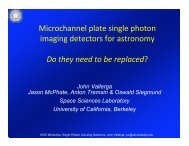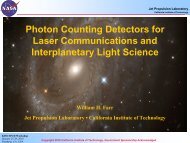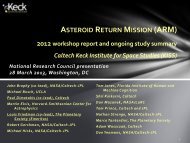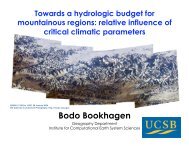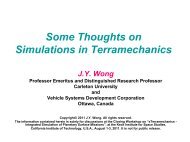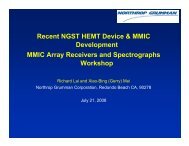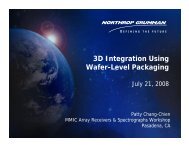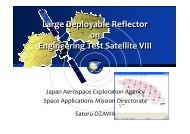Target NEO: Open Global Community NEO Workshop Report
Target NEO: Open Global Community NEO Workshop Report
Target NEO: Open Global Community NEO Workshop Report
You also want an ePaper? Increase the reach of your titles
YUMPU automatically turns print PDFs into web optimized ePapers that Google loves.
DRAFT: RELEASED FOR PUBLIC COMMENTThe dynamical models and observational data necessary for this understanding will also be directlyapplicable to any debris generated by crew or spacecraft activity at the target asteroid. We donot have a good current sense of how a <strong>NEO</strong> surface would respond to interaction (particularly interms of dust generation), or how proximity operations might be affected. This will likely require agravity model to be generated for the target, which will include shape, size, and density distributionas inputs.Proximity operations and Extra-Vehicular Activity (EVAs) will also depend on the topography andoverall geology of the target <strong>NEO</strong>, for both scientific and engineering reasons. The regolith propertiesand internal structure will have critical influence on anchoring strategies (or if alternatives toanchoring need to be developed). This, in addition to composition, will help guide sample collectionplans. For example, expected variability would render samples from disparate sites desirable, whileareas of different surface exposure ages would allow study of space weathering processes.4.3 Robotic Precursor MissionsAs discussed above, much work remains to be done in understanding asteroids to the degree necessaryto allow safe and significant human exploration. Some of the required data can be obtainedthrough Earth-based facilities, though the amount and kind of data will vary depending on thetarget, the timing of any close passes to Earth, and the part of the sky in which it appears; aclose pass in the far southern part of the sky would make study by large telescopes more difficultand might preclude radar, for example. Because a human exploration target would be a very highpriority target, however, we might expect a suite of ground-based and space-based facilities to beavailable and would likely be able to determine at least a size, composition, and axial ratios, withat least constraints on thermal properties and the presence of satellites. If the candidate target ispart of a multiple system, constraints on the mass and density can be calculated, but, as noted, itis not clear that a multiple system will be judged a safe target. Figure 4 shows the type of shapemodels that can be generated by Earth-based data, with a combination of radar and lightcurveinformation used to create a shape model for Itokawa that compares very well with the Hayabusaapproach imagery. 4Figure 4 demonstrates the level to which Earth-based study can reach, as an example of whatmight be expected before in situ precursor missions are launched. Before Hayabusa arrived atasteroid (25143) Itokawa, the shape model on the left was generated from radar and lightcurvedata, and it compares well with the Hayabusa approach image on the right. In addition, Binzelet al. successfully predicted Itokawa’s composition [8]. However, details of the asteroid’s geologyrequired Hayabusa’s arrival and close approaches to Itokawa, and geotechnical details such as howanchoring might work on Itokawa’s surface are still unknown.Detailed radar imaging shows that many of the <strong>NEO</strong>s with rotation periods less than 3 hours haverelatively spheroidal shapes and equatorial bulges, thought likely due to transport and accumulationof regolith via YORP spin-up.Additional information will be required, however, which can only be obtained by precursor missionsdesigned to interact in situ with near-Earth asteroids. Detailed shape data, density variations and4 Figure courtesy of L. A. M. Benner (NASA-JPL), personal communication.DRAFT: RELEASED FOR PUBLIC COMMENT 13




